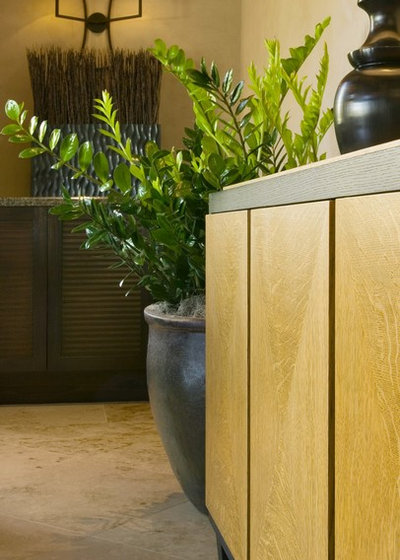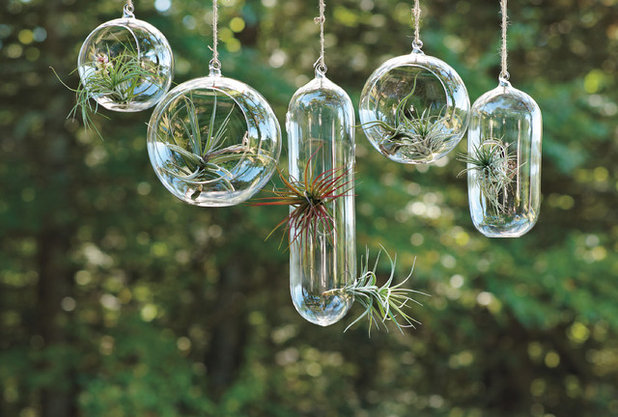Our 10 Hottest Indoor Plants
For the easiest way to brighten a room in a pinch, a beautiful indoor plant is your answer – here are our top picks for the home
Maya Anderson
25 July 2014
Houzz Contributor based in Perth, Western Australia, writer of House-Nerd.com, homes and architecture journalist, newspaper columnist. Renovating our first house, The Crap Shack, step by step! I specialise in writing stories about all things home.
Houzz Contributor based in Perth, Western Australia, writer of House-Nerd.com, homes... More
If you are looking for that single, secret ingredient that has the ability to make just about any room look better, it’s a plant. The humble house plant is well and truly back on trend, and for good reason. A splash of healthy greenery instantly lifts a space to make a room feel fresh and welcoming. On top of that, indoor plants are great for purifying the air, creating a healthier home. If you feel like one of your rooms is lacking a little something, try adding one of our favourite plants for the home.
1. Fiddle Leaf Fig
Ask anyone who owns a Fiddle Leaf Fig (Ficus lyrata) about their plant and, chances are, they will tell you how much they adore it. Fiddle Leaf Fig mania has taken the interior design world by storm in recent years. Loved for their large glossy, leathery leaves, they make great house plants. They are fantastic as larger specimen plants – in a large container they can easily grow to around two metres tall.
Ask anyone who owns a Fiddle Leaf Fig (Ficus lyrata) about their plant and, chances are, they will tell you how much they adore it. Fiddle Leaf Fig mania has taken the interior design world by storm in recent years. Loved for their large glossy, leathery leaves, they make great house plants. They are fantastic as larger specimen plants – in a large container they can easily grow to around two metres tall.
Great for: This plant adds a sculptural element and wow factor to a room.
Light: Place near a window that gets bright filtered light, but keep away from harsh direct sunlight to prevent leaf burn.
Water: As they hail from a tropical climate, most experts advise keeping this ficus steadily moist and in a warm room where possible.
Tip: Do not allow it to sit in too much water or it can suffer from root rot.
Read more about the Fiddle Leaf Fig here
Light: Place near a window that gets bright filtered light, but keep away from harsh direct sunlight to prevent leaf burn.
Water: As they hail from a tropical climate, most experts advise keeping this ficus steadily moist and in a warm room where possible.
Tip: Do not allow it to sit in too much water or it can suffer from root rot.
Read more about the Fiddle Leaf Fig here
2. String of Pearls
With its long tendrils of trailing foliage covered in pea-like beads, the unique String of Pearls (Senecio rowleyanus) creeping succulent is an ideal plant to add to a quirky room. Pot in well-draining sandy soil and place in a spot where its trailing foliage can hang down and cascade freely.
With its long tendrils of trailing foliage covered in pea-like beads, the unique String of Pearls (Senecio rowleyanus) creeping succulent is an ideal plant to add to a quirky room. Pot in well-draining sandy soil and place in a spot where its trailing foliage can hang down and cascade freely.
Great for: This odd-looking plant makes a great talking point and can be easily shared with friends. Place a cutting or two in a spare pot of soil and they will easily take root.
Light: This plant likes bright light, including direct sunlight.
Water: Give it a drink every two weeks in summer and once a month in winter.
Tip: Keep in a spot out of reach of drafts, open windows and air-conditioning vents as the cold air can cause leaf drop. String of Pearls is considered to be somewhat toxic so keep out of reach of children and pets.
Light: This plant likes bright light, including direct sunlight.
Water: Give it a drink every two weeks in summer and once a month in winter.
Tip: Keep in a spot out of reach of drafts, open windows and air-conditioning vents as the cold air can cause leaf drop. String of Pearls is considered to be somewhat toxic so keep out of reach of children and pets.
3. String of Bananas
The more slender cousin of String of Pearls, this trailing succulent produces long tendrils of tiny green banana-like leaves. String of Bananas (Senecio radicans) looks great planted on its own and pruned every so often to grow full and thick. It is also beautiful placed in a pot with other succulent varieties.
The more slender cousin of String of Pearls, this trailing succulent produces long tendrils of tiny green banana-like leaves. String of Bananas (Senecio radicans) looks great planted on its own and pruned every so often to grow full and thick. It is also beautiful placed in a pot with other succulent varieties.
Great for: Pop into hanging baskets or place in pots on windowsills where its beautiful foliage can trail.
Light: This plant enjoys filtered sunlight.
Water: Water when the soil is dry to the touch. This drought-tolerant succulent likes porous soil with good drainage.
Tip: Keep away from children and pets who might be tempted to munch on it, as it is toxic.
Read more about String of Pearls and String of Bananas here
Light: This plant enjoys filtered sunlight.
Water: Water when the soil is dry to the touch. This drought-tolerant succulent likes porous soil with good drainage.
Tip: Keep away from children and pets who might be tempted to munch on it, as it is toxic.
Read more about String of Pearls and String of Bananas here
4. Devil’s Ivy
Many of those who bemoan their black thumbs are delighted to find they have success with Devil’s Ivy (Pothos). This trailing lush leafy vine will put up with infrequent watering and neglect. In its native tropical jungle habitat, Devil’s Ivy can grow to 12 metres in length, but in the home a couple of metres is common. They are some of the best plants for purifying indoor air.
Many of those who bemoan their black thumbs are delighted to find they have success with Devil’s Ivy (Pothos). This trailing lush leafy vine will put up with infrequent watering and neglect. In its native tropical jungle habitat, Devil’s Ivy can grow to 12 metres in length, but in the home a couple of metres is common. They are some of the best plants for purifying indoor air.
Great for: Those who don’t have an interest in gardening will like this plant. It adds an inviting, homey touch to a room.
Light: Devil’s Ivy can tolerate low-light areas.
Water: Once a week will do nicely.
Tip: Prune for a fuller-looking, robust plant. Keep out of reach of inquisitive babies, dogs and cats, as this plant is toxic.
View the full plant profile (including care instructions) for Devil’s Ivy
Light: Devil’s Ivy can tolerate low-light areas.
Water: Once a week will do nicely.
Tip: Prune for a fuller-looking, robust plant. Keep out of reach of inquisitive babies, dogs and cats, as this plant is toxic.
View the full plant profile (including care instructions) for Devil’s Ivy
5. ZZ Plant
With its exotic looks, glossy green leaves and ability to tolerate neglect, the ZZ Plant (Zamioculcas zamiifolia) has been the pride of many a black thumb. A tropical perennial plant hailing from eastern Africa, it is hard to kill, slow-growing and ideal as an office plant or table centrepiece.
With its exotic looks, glossy green leaves and ability to tolerate neglect, the ZZ Plant (Zamioculcas zamiifolia) has been the pride of many a black thumb. A tropical perennial plant hailing from eastern Africa, it is hard to kill, slow-growing and ideal as an office plant or table centrepiece.
Great for: Homeowners looking for a very low-maintenance plant will like this one.
Light: This plant likes bright, indirect light.
Water: Give it a drink every two weeks.
Tip: Keep out of reach of inquisitive babies, dogs and cats, as this plant is toxic.
ZZ Plant: Meet a Long-Lasting Houseplant With a Forgiving Heart
Light: This plant likes bright, indirect light.
Water: Give it a drink every two weeks.
Tip: Keep out of reach of inquisitive babies, dogs and cats, as this plant is toxic.
ZZ Plant: Meet a Long-Lasting Houseplant With a Forgiving Heart
6. Madagascar Dragon Tree
With its low light and water needs, and compact, structural shape, the hardy Madagascar Dragon Tree (Dracaena marginata) is hugely popular and great for adding impact and texture to a clean-lined room.
With its low light and water needs, and compact, structural shape, the hardy Madagascar Dragon Tree (Dracaena marginata) is hugely popular and great for adding impact and texture to a clean-lined room.
Great for: Contemporary and modern interiors will benefit from this tree.
Light: A bright spot by a window is ideal.
Water: About once a month, when the soil feels slightly dry, water thoroughly until the water drips through the drainage holes. Discard water in the drainage saucer where possible – do not allow plant to sit in water otherwise the roots will rot.
Tip: To control the height and create a bushier plant, simply prune the top. You can grow a new plant from a cutting by dipping it in rooting hormone and placing in water – in a few weeks two new stems will grow from the cut, creating thicker-looking foliage. It is then ready to be planted in soil.
Read more about the Madagascar Dragon Tree here
Light: A bright spot by a window is ideal.
Water: About once a month, when the soil feels slightly dry, water thoroughly until the water drips through the drainage holes. Discard water in the drainage saucer where possible – do not allow plant to sit in water otherwise the roots will rot.
Tip: To control the height and create a bushier plant, simply prune the top. You can grow a new plant from a cutting by dipping it in rooting hormone and placing in water – in a few weeks two new stems will grow from the cut, creating thicker-looking foliage. It is then ready to be planted in soil.
Read more about the Madagascar Dragon Tree here
7. Maidenhair Fern
While they are not the easiest house plants for beginners to master, the Maidenhair Fern (Adiantum) can be a wonderful addition to a home with their beautiful softly textured foliage. It needs to be kept moist, so it isn’t for the forgetful house plant gardener. But, if you can remember, it can reward you with beautiful greenery for years to come.
While they are not the easiest house plants for beginners to master, the Maidenhair Fern (Adiantum) can be a wonderful addition to a home with their beautiful softly textured foliage. It needs to be kept moist, so it isn’t for the forgetful house plant gardener. But, if you can remember, it can reward you with beautiful greenery for years to come.
Great for: These plants add softness and texture to a traditional or retro room scheme with their delicate-looking foliage.
Light: Place the fern in a brightly lit position clear of draughts.
Water: Keep moist. A great idea to keep your indoor Maidenhair Fern from dehydrating is to plant it in a self-watering pot which allows the plant to take up as much water as it needs. You just need to remember to top up the reservoir.
Tip: Apply diluted liquid fertiliser, such as fish emulsion, regularly. Do not allow to dry out even for a day or two.
View the full Maidenhair Fern plant profile here
Light: Place the fern in a brightly lit position clear of draughts.
Water: Keep moist. A great idea to keep your indoor Maidenhair Fern from dehydrating is to plant it in a self-watering pot which allows the plant to take up as much water as it needs. You just need to remember to top up the reservoir.
Tip: Apply diluted liquid fertiliser, such as fish emulsion, regularly. Do not allow to dry out even for a day or two.
View the full Maidenhair Fern plant profile here
8. Mother-in-law’s Tongue (Snake Plant, Saint George’s Sword)
Named for its long, sharply-shaped leaves, this structural plant with its strong, elongated leaves has shed its daggy ’70s reputation. These days, Mother-in-law’s Tongue (Sansevieria trifasciata) is enjoying a massive resurgence as an on-trend indoor and architectural plant. One of its best features is its incredible hardiness.
Named for its long, sharply-shaped leaves, this structural plant with its strong, elongated leaves has shed its daggy ’70s reputation. These days, Mother-in-law’s Tongue (Sansevieria trifasciata) is enjoying a massive resurgence as an on-trend indoor and architectural plant. One of its best features is its incredible hardiness.
Great for: It adds structure to modern, contemporary, retro and eclectic interiors.
Light: Although Mother-in-law’s Tongue is forgiving and can tolerate many conditions, it prefers full, bright light.
Water: Water only once a month. The only way to kill this hardy plant is by overwatering.
Tip: This plant can be divided and shared easily with friends and looks great massed with other indoor plants, like in this home.
Mother-in-Law’s Tongue: Surprisingly Easy to Please
Light: Although Mother-in-law’s Tongue is forgiving and can tolerate many conditions, it prefers full, bright light.
Water: Water only once a month. The only way to kill this hardy plant is by overwatering.
Tip: This plant can be divided and shared easily with friends and looks great massed with other indoor plants, like in this home.
Mother-in-Law’s Tongue: Surprisingly Easy to Please
9. Umbrella Tree
Chances are you might recall this plant from its retro era days. This hard-to-kill houseplant is now making a comeback, loved for its pretty foliage and hardy nature. Umbrella Tree (Schefflera actinophylla) will flourish if it receives plenty of water and regular fertilising.
Chances are you might recall this plant from its retro era days. This hard-to-kill houseplant is now making a comeback, loved for its pretty foliage and hardy nature. Umbrella Tree (Schefflera actinophylla) will flourish if it receives plenty of water and regular fertilising.
Great for: It adds life and impact to a corner of a room, as the height of the plant is one of its great features.
Light: Indirect sunlight is best.
Water: These plants love humid environments and moist soil, so water weekly and spray frequently.
Tip: The Umbrella Tree loves warm humid conditions. Fertilise in its growing season with liquid fertiliser or slow-release pellets.
Find out more about the Umbrella Tree
Light: Indirect sunlight is best.
Water: These plants love humid environments and moist soil, so water weekly and spray frequently.
Tip: The Umbrella Tree loves warm humid conditions. Fertilise in its growing season with liquid fertiliser or slow-release pellets.
Find out more about the Umbrella Tree
10. Air Plants
Air Plants (Tillandsia) are super on trend at the moment, popping up in the hottest restaurants, bars and in displays at interior design expos. Yet while they are called Air Plants, one of the most common urban legends is that they do not need to be given any water. Incorrectly, many people believe they can thrive on air or humidity alone and do not need any care.
Air Plants grow differently to most other house plants as they are covered in suction scales that capture moisture. They can only obtain water if it is on their leaves through dew, rain and fog. As house plants, they can thrive given regular water misting with a spray bottle.
Air Plants (Tillandsia) are super on trend at the moment, popping up in the hottest restaurants, bars and in displays at interior design expos. Yet while they are called Air Plants, one of the most common urban legends is that they do not need to be given any water. Incorrectly, many people believe they can thrive on air or humidity alone and do not need any care.
Air Plants grow differently to most other house plants as they are covered in suction scales that capture moisture. They can only obtain water if it is on their leaves through dew, rain and fog. As house plants, they can thrive given regular water misting with a spray bottle.
Great for: They add interest to walls or placed in glass globes hanging from the ceiling.
Light: Bright, filtered light is ideal. Keep Air Plants that are placed in glass globes away from direct sunlight.
Light: Bright, filtered light is ideal. Keep Air Plants that are placed in glass globes away from direct sunlight.
Water: If you are growing Air Plants indoors and the air is dry, mist two times a week with a spray bottle and submerge the whole plant in a container of water for three hours every one to two weeks. If grown in a glass globe, mist with water with just one spray for tiny globes and two or three for larger globes. Over-misting can kill the plant.
Tip: After submerging your plant to wet it thoroughly, turn it upside down and gently shake to avoid water collecting near the base, which can be detrimental to your plant’s health.
See how you can incorporate air plants in your home
Tip: After submerging your plant to wet it thoroughly, turn it upside down and gently shake to avoid water collecting near the base, which can be detrimental to your plant’s health.
See how you can incorporate air plants in your home
Related Stories
Architecture
What is an Architect… And How Do I Work With One?
By Niki Bruce
Get expert advice on why you might need an architect to design your new home
Full Story
Living Rooms
Yes, You Can Do Without a Sofa in the Living Room!
This is how to create a more appealing and cosy atmosphere in your living room without the need for a sofa
Full Story
Most Popular
14 HDB Walk-in Wardrobes to Copy
In a housing typology that's not designed to have walk-in wardrobes, these designs are just the solution
Full Story
Most Popular
4-Room BTO Flat: 1 Floor Plan, 3 Different Looks
By Jasmine Goh
Think you're limited by your flat's cookie-cutter layout? These three homes – and their designers – show otherwise
Full Story
Working with Pros
What is an Interior Designer… And How Do I Work With One?
By Niki Bruce
Hear expert advice to understand the role an interior designer plays in your renovation process
Full Story
Bathroom Ideas
8 Sneaky Ways to Disguise HDB Piping
By Disa Tan
Though these bathroom pipes are in plain sight, they certainly aren't unsightly
Full Story
Interior Design
Golden Rules of Interior Design Everyone Should Know
There are guidelines will stand you in good stead in your renovation or decorating project
Full Story
Kitchen Guides
The Key Measurements You Need to Know to Design Your Kitchen
Understanding spatial relationships, building dimensions and work zones will help you get the ideal kitchen setup
Full Story
Most Popular
Why Build a Platform Bed
Need more reasons to ask your designer to custom-build a platform bed for your room? Here are six
Full Story
Working with Pros
What is a Renovation Contractor… And How Do I Work With One?
By Niki Bruce
Get expert advice on why you might need to work with a renovation contractor for your new home
Full Story

































If you're looking for something a bit different, check out a ponytail plant. They grow slowly but can reach over 8 feet tall. They're easy to care for, look great, and they're more prized in Europe than America, so you'll have something unique.
The other one I like is a Hoya plant. If you can put it in a cool North window, it will produce very showy white flowers in the winter.
Brenda Wale, my mom grew a ponytail plant more than 30 years ago. I’ve not seen them for sale in the nurseries available to me since then. So I guess they are indeed hard to find.
I also loved piggyback plants ( Tolmiea menziesii) and prayer plants (Maranta leuconeura). Not statement plants but very beautiful just the same.
I love indoor plants and I have over 70 now although I still don't think I have allot in any one room, perhaps the bathroom I have about 16 albeit small plants.
I love to have different plants too rather than allot of one species so it has proven to be harder and harder to find something new but now I have two ponytail palms in my home and they are doing great. I also have one outside and it was about the size of an apple when I first planted it in 2004 and now it's about the sise of a car tyre and whilst it's cold enough in winter, we don't have snow, frost at best and it handles that temp without any issues I'm in southern Australia for reference.